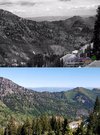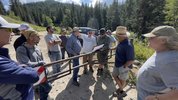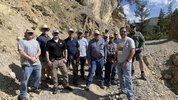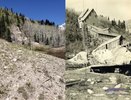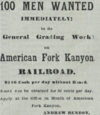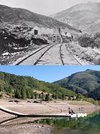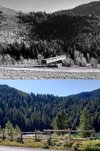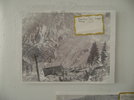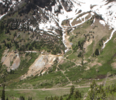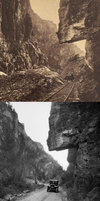Where did all those miners live? While many lived in Deer Creek and Forest City (and perhaps this mythical Carbonate), many lived adjacent to the mines they worked. Cabins remains can be found at sites throughout the canyon, Major Evans, Mary Ellen, Miller Hill, the Dutchman and Pacific Mine, Pittsburg Lake, Holman Flats, etc.
Another Before & After from American Fork Canyon. This vantage point is high on Miller Hill, looking northeast into Mineral Basin (the near valley) and into the Midway/Heber Valley with the Uinta Mountains on the horizon. The road/trail that can be seen in the bottom left of the photos is the Pittsburg Lake Trail, leading to mines such as the Smuggler Tunnel and Centennial Tunnel. The cabin and mine tailings in the bottom right are at Bredemeyer Mine, first located in 1875 by William Bredemeyer (resident of Forest City). Other mines on Miller Hill include the Kalamazoo, Orion, Oliver, Knights of Pythias, Wild Dutchman, etc and were operated by names like Jesse Knight (of Knightsville/Eureka fame) and George Tyng (the nearby gravesite ExpeditionUtah restored). All of these mines were closed/reclaimed in the 1990’s as part of an abandoned mine reclamation project. While the mines are closed, the history is worth the visit if you know where to look.
